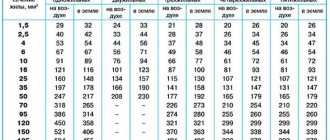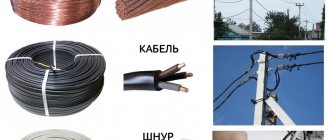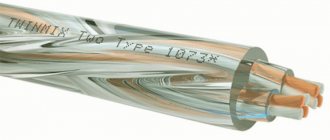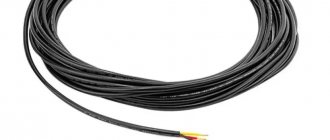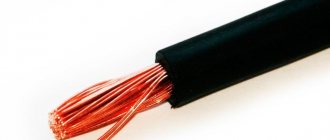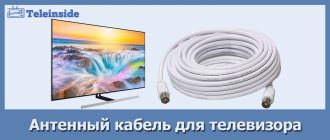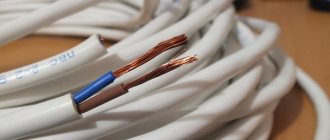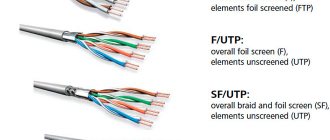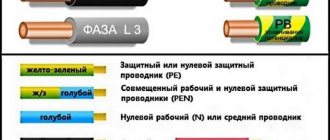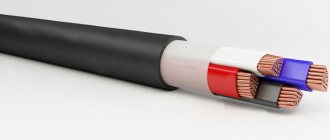Difference between cable and wire
The question, by the way, is not simple. In particular, in accordance with SN, from the times of the USSR to the present day, work with cables is more expensive than with wires. However, there was no very clear classification in this regard, either in past times or today. Different sources provide a variety of perspectives. In practice, the characteristic “cable” or “wire” is assigned by GOST/TU for the production of a specific brand. In particular, the GDP brand cable from Odeskabel OJSC differs from the PVS brand wire only in the configuration of the sheath: the GDP cable is flat, and the PVS wire is round. And in no reference book about cables is the shape of the cable/wire sheath indicated as an insignificant factor. Therefore, you need to look at the certificate - it will certainly be stated there: this is a cable or wire.
Total: how to choose a cable for wiring?
- We decide on the type of cable. NYM would be a better choice, but this wire is quite expensive. If your budget is limited, you can take VVG. For wiring in wooden houses, it is better to use the “ng” type, that is, non-flammable.
- We decide on the number of cores . If you have a single-phase network with grounding, you need three wires: phase, neutral and ground. Without grounding - two. For a three-phase network, cables with four cores (three phases and zero) are used.
- We calculate the cable cross-section. We calculate the maximum load from consumers, multiply by a safety factor of 1.5 and look at our plate.
Calculation of cable cross-section
There are reference plates indicating what cross-section of aluminum/copper conductor is needed for the assigned load. However, most electricians use a simple formula (consider a load of 8 kW): a copper cable cross-section of 1 mm2 can pass through 10A or 2.2 kW (power = 10A x 220V).
Therefore, a load of 8 kW in A will be equal to 36 A (load = 8 kW / 220V), and for a similar amount of current a cable with a cross-section of 4 mm2 .
This calculation is more or less suitable for cables with a cross-section of no more than 6 mm2. For large cross-sections, tables of “Permissible current loads” are needed.
With an equal load, the cross-section of the aluminum cable should be almost 30% larger than that of copper. The cable cross-section is the cross-sectional area of the core that conducts current.
The cross-section of a round current-carrying cable core is obtained according to the formula for the area of a circle S = π × r2, where the number π = 3.14, and r is the radius.
When there are a couple of wires in the core, then the cross-section of the core will be equal to the sum of the cross-sections of all the wires. The radius of the wire is measured with a caliper, and for very thin wires with a micrometer. How much cross-sectional margin is required? The reserve will undoubtedly not be superfluous. However, you need to know the limit.
For example, the limit of ordinary household socket-switches is 16A (3.2 kW = 16A x 220V) and connecting the socket using a 4 mm2 cable, with a throughput of 8 kW, is an inappropriate expenditure of finances.
And also, a cable with a cross-section of 4 mm2 will not fit into every socket.
Rational cross-sections in household electrical networks for copper: 1.5-2.5 mm2 for sockets and 0.75-1.5 mm2 for lighting.
VVG cable
The VVG cable is used for wiring in networks with voltages up to 1 kV. The number of cores in the bundle can be from 1 to 6. The letters VVG are deciphered as follows:
- B - the first layer of PVC insulation.
- B - second layer of PVC insulation.
- G - insulation without an additional protective layer (armor).
Additionally, some types of VVG wire may have the designation “ng”. These letters mean that the wire is flame retardant. Thus, if a high temperature occurs due to a short circuit, the wire will melt, but will not burn. We recommend using this type of VVGng wire for installing electrical wiring in an apartment.
There are also VVG types with the designations “P” and “Z”.
- P means that the wire in the wire is flat;
- 3 - that the space between the cores and the outer insulation is filled with PVC plastic.
Here is an example of a flat flame retardant cable REXANT VVG-Png-LS 3x2.5:
The advantage of the VVG cable is the ability to use it in conditions of low and high temperatures from -50 to +50 degrees. Also, in comparison with other types, it is much cheaper. For example, VVGng 3x2.5 costs on average from 35 - 40 rubles per 1 m, and NYM 3x2.5, which has similar characteristics, costs about 55 - 60 rubles. If the house is large, the difference in wiring costs can reach a couple of thousand rubles.
VVG wire cores can be single- or multi-wire. Multi-wire ones are more flexible than single-wire ones, but they are also a little more expensive. Single-wire ones have a cross-section from 1 to 50 mm2, and multi-wire ones from 16 to 240 mm2. It is worth noting that for residential wiring, cables with a cross-section of 1.5 to 6 mm2 are usually used.
The bending length of the VVG wire (at turns in the groove) is equal to the cross-section of the entire bundle multiplied by 10. That is, if you have a wire with a cross-section of 5 mm, then the bending radius should be at least 50 mm.
Which cable to choose: copper or aluminum?
Many “experts” will say with absolute certainty - copper. Why? For the consumer, copper, compared to aluminum, is advantageous in that sooner or later copper does not deteriorate so quickly, and this is very significant when replacing lamps, etc. Whether it is necessary to pay three times more for this is a decision for the consumer.
You only need to connect copper and aluminum cables using a terminal block so that the aluminum does not come into contact with the copper.
Because due to some physical phenomena at the point of contact between aluminum and copper, the current resistance increases after some time. As a result, the connection point heats up extremely intensely, the cable breaks, a short circuit occurs, and in extreme cases, a fire. By the way, the connection of any heterogeneous materials with different resistance leads to a similar result.
As a result, there is no need to sharpen the wiring with the first wire you come across by twisting it.
Depending on the area of use of the cable, the conductor is made from a variety of materials: first copper and aluminum, then nichrome, steel, etc. When you are not assured of the uniformity of the material of the cables being connected, use a terminal block.
PUNP cable
This is a budget type of cable for electrical wiring. It is a flat two or three-core wire with a core cross-section from 0.75 to 6 mm2. PUNP stands for as follows:
- P - wire.
- UN is universal.
- P - flat shape.
Also in the abbreviation the letter “G” is sometimes found, which means that the wire is flexible. Its main advantage is its low cost compared to VVG and NYM.
There is an opinion among electricians that PUNP wire is prohibited for manufacture and use. Indeed, on June 1, 2007, a ban was introduced on the use of TU 16.K13-020-93 by members of the Elektrokabel association. However, manufacturing plants continue to produce and sell PUNP. In Russia they can be purchased freely.
Concerns about the use of PUNP are well founded. Statistics of fires caused by electrical wiring fires showed that in 60% of cases the source of fire was the PUNP cable type. The reason for this is that TU 16.K13-020-93 states that during the manufacture of wires, a deviation of 30% from GOST 22483-77 in the cross-section of current-carrying conductors is allowed. This means that, for example, a wire with a nominal cross-section of 4 mm2 may well be 2.9 mm2 or even less.
In general, whether to buy PUNP or not is up to you. In any case, if you have the means, it is better to purchase a wire of good quality once and not be afraid of a fire.
Which cable is optimal: flexible or rigid?
A rigid cable is usually a single-core cable, and a flexible cable is usually a multi-core cable. The greater the number of wires in the core and how thinner each wire is, the more elastic the cable.
Based on flexibility, the cable is divided into 7 classes: monocore is class 1, and class 7 is the most flexible.
As the flexibility class of the cable increases, its price increases. A rigid cable is used for inserting into walls and laying in the ground, and a flexible cable is used for connecting maneuverable devices or electrical appliances. From an operational point of view, it doesn’t matter which cable to choose - rigid or flexible. From an installation point of view, every electrician has his own wishes. By the way: the ends of the flexible cable, which are embedded in sockets (switches), must certainly be soldered or crimped using special ends. For a rigid cable, a similar procedure is not necessary. To connect lighting equipment, it is better to purchase a flexible cable, because lighting devices are often replaced, and a rigid cable is more likely to break when connecting new electrical equipment.
Features of connecting electrical equipment
In almost every apartment there is a need to connect high-power household appliances, for example, an electric stove, to a power outlet.
To connect the electric stove to a power outlet, flexible stranded wires are required. Suitable brands NYM, KG with a cross section of 3x6 mm2.
To lay the electrical wiring to the power socket for the hob, you need to use a VVGng cable - LS 3x6 mm2. So, to install the hob, you need to select a wire whose certificate contains a clause stating that the wire is applicable for this equipment.
Which wires won't work?
There are types of wires that should never be used for electrical wiring. What types of products do they include?
PVS wire
Copper stranded wire with polyvinyl chloride insulation and a common sheath. It has from 2 to 5 conductors and a cross-sectional area of 0.75-10 mm2.
Designed for a rated voltage of 0.38 kW, it can be used to connect household electrical appliances to the electrical network or for the manufacture of extension cords.
Not suitable for fixed wiring installations because:
- The wire is stranded and connecting the ends will require soldering and tinning, which is extra time and requires experience.
- Due to the wire strands, it heats up faster, the insulating sheath wears out faster and a short circuit may occur.
- The PVS wire must not be laid in a bundle. Since the wiring lines must be located at a certain distance from each other, it will be necessary to make grooves in the wall.
Wires PVVP, ShVVP
They have single- or multi-wire copper conductors and are used only for connecting electrical equipment and household appliances.
IMPORTANT! They are not suitable for stationary electrical communications, since these wires do not have a non-flammable insulating sheath.
Also, the service life of these wires is short, and the multi-core structure must be soldered during installation and the ends must be processed.
For low-current lighting up to 0.024 kV, a flat PUNP cord is used, but it is not suitable for installing electrical networks.
It is worth noting the PUNP wire; it has been prohibited for wiring in residential premises since 2007. This wire has low insulation and low power, so it cannot withstand the load of modern electrical appliances.
How to independently determine the quality of the cable?
Many manufacturers do not always comply with cable manufacturing standards. Their main “trick” is to underestimate the cross-section of the conductor. And sometimes significantly. Of course, it is difficult to examine the cross section at the point of purchase. In the store you can measure any wire with a caliper and a micrometer.
You can also come across cables with a reduced sheath thickness or with a sheath made of low-quality material, and this reduces the service life of the cable.
For inspection, it’s a good idea to have a piece of the “correct” cable with you as a standard. In stores you can come across a Chinese cable made of aluminum covered with copper (sold as copper with markings in Cyrillic).
It is easy to inspect such a cable: the cut of the current-carrying core on the cable gleams white - it is aluminum.
There are manufacturers who use low-quality copper or aluminum to reduce costs. Such cables have a much lower service life and conductivity than those required by GOST. It is possible to test the quality of the metal of a current-conducting core as follows:
- try bending and straightening the cable a couple of times. In factories, such a test is performed on a special bending mechanism under a certain bending radius. Of course, your number of bends will be less than those provided for in GOST. However, in any case, aluminum should withstand at least 7-8 bends, and copper - 30-40. After this, deformation of the insulation and wire breakage are possible. It is better to carry out the experiment at the end of the cable, so that you can simply cut it off later.
- a cable made of high quality copper/aluminum should bend and not spring;
- the copper/aluminum core on the stripped cable should have a bright (glare) color. When the vein is heterogeneous in color and there are hopeless spots, this indicates large impurities in the metal and its low quality.
Nevertheless, an amateur will not be able to determine the quality of the cable 100% on his own. In this case, there is only one recommendation - rely on the brand and purchase it in large, trusted stores.
When should cables be replaced?
Replacement of electrical networks can be complete or partial. Performed in the following cases:
- Long service life of wiring. If you have moved into a new apartment, it is advisable to carry out major renovations after about 20 years. During this period, installed engineering communications become unusable and can pose a danger to human health.
- Repair or change of layout. Technology moves forward and modern household appliances are very powerful, so increased demands are placed on wiring. It is not recommended to connect new devices to the old electrical network, as their characteristics may not match. If you are planning to purchase a new hob, dishwasher, modern refrigerator, etc., then it is worth updating the wiring in the apartment or at least in the places where the equipment is supposed to be installed.
Regardless of the reasons, work on replacing wiring should always be organized by developing an electrical wiring diagram and selecting materials for further work.
All types of cable are made of non-ferrous metals, which is why the cable is accepted at any scrap metal purchasing point. Recently, prices for non-ferrous metals have been constantly rising. Follow the link to view the current prices for cable reception: https://citylom.ru/priem-kabelya
What kind of insulation and sheath should the cable have?
It is best when the insulation and sheath of the cable are double insulated. A single-insulated cable has a service life of up to 15 years, while a double-insulated cable usually lasts 2 times longer. Typically, “insulation” and “sheath” are 2 different materials. The insulation is the layer of dielectric material that goes immediately behind the conductive core, and the sheath is all the layers on top of the insulation. The sheath is intended to protect the cable from various mechanical influences. The cable may have a couple of layers of sheath made of different types of material. Certain types of shell that may be useful:
- Heat-resistant cables are designed for installation in rooms with high temperatures (saunas). Typically, the material used is fluoroplastic, with fiberglass on top. There are no special designations for such cables, i.e. if necessary, you need to seek help from reference books or catalogs, where the value of the “operating temperature” is indicated precisely;
- non-flammable, marked “ng” - indicates the ability to self-extinguish when the flame disappears, but cannot withstand high temperatures
- when the cable brand contains “FR” (fire resistant) and then E30, E90 or E120, then this cable can “function” in an open fire for 30, 90 or 120 minutes;
- cables with a polyethylene sheath can be pulled both in the soil and in an open way (for example, along the walls of houses);
- cables with insulation and sheath made of PVC (polyvinyl chloride) are used for pulling inside buildings (under plaster) or in cable ducts.
Classification of cables for wiring
Each cable consists of several copper cores of a certain cross-section. In turn, the cores in the cable can be single-wire monolithic or multi-wire. Each core is enclosed in a protective sheath made of rubber, polyethylene or PVC plastic. Note that any cable used for electrical wiring has at least two layers of insulation: the first envelops the core, and the second collects all the conductive wires into a bundle.
The most popular types of wires for wiring in a house and apartment are:
- VVG
- NYM
- PUNP
Let's look at what these types of cables are and where they are used.
The most famous cable brands
- wire PPV (copper), APPV (aluminum) in single insulation - for pulling inside walls;
- cable PVS (copper), GDP (copper) in double insulation - for pulling inside buildings;
- heat-resistant cables RKGM (copper) - up to 180°C, BPVL (tinned copper) - up to 250°C;
- cable VVG (copper), AVVG (aluminum) - for stretching along the walls of houses and in the ground;
- runway cable (copper) water-submersible - for pulling in water;
- TPP cable (copper) telephone pair - for pulling in the ground;
- TRP wire (copper) telephone distribution for subscriber communications (switching on the telephone)
- twisted pair cable UTP, FTP - for organizing computer networks, turning on intercoms, etc.;
- “Alarm” signal wire for connecting intercoms, security and fire alarms, etc.;
- coaxial cable RG-6 for connecting TVs, antennas, CCTV cameras.
Internet cable
The concept of “Internet cable” generalizes many types of cable products. A variety of information cables are used to broadcast information. If you mean connecting to the Internet, then you need to check with the operator which cable needs to be laid across the walls. In this case, it is necessary to find out both the brand of the cable and the manufacturer in order to accurately determine compatible cable products.
For example, for the Internet they use a regular television cable TM Finmark, a twisted pair cable or an existing subscriber cable (the so-called “noodles”) to which the telephone is connected.
Optical cables can be laid on dedicated Internet lines.
Computer cable
The term is also general.
As a rule, a twisted pair cable is used to connect PCs with each other and with the server, but other information cables can also be used.
The technology of twisting two wires into a pair has been used in telephony since the last century. Due to the correctly calculated twisting pitch and the quality of the material, a maximum information transfer speed was achieved than that of a standard paired telephone cable. There are quite a few types of twisted pair cables, depending on the number of cores, the diameter of each core, installation locations, etc. Depending on the data transfer speed, twisted pair cables are divided into groups:
- 3rd category (standard telephone cable),
- 5th category (office networks),
- 6th category (new generation cable for changing category 5).
“Twisted pair”, which has gained the greatest popularity in our time, is a category 5 cable made of 8 pairs of twisted cores, the core diameter is a minimum of 0.45 mm and a maximum of 0.51 mm.
NYM cable
The NYM cable is applicable in networks with voltages up to 0.66 kV. The number of conductors in the bundle is from 2 to 6. In addition to the current-carrying conductors, there may be a yellow-green grounding conductor. Although the cable is mostly used for indoor wiring (it is afraid of ultraviolet radiation), it can also be used for outdoor installation if it is placed in a protective sleeve (plastic pipes, boxes, etc.). NYM stands for as follows:
- N - standard type wire (German classification).
- Y - sheath of cores made of PVC plastic.
- M - there is an outer shell (most often also made of PVC).
Additionally, the wire may have the symbol “J”, which indicates the presence of a grounding conductor in the harness. It is worth noting that NYM is initially manufactured with insulation that does not support combustion, so you should not look for the letters “ng” in the marking. However, unlike VVGng, the NYM cable can withstand lower temperature loads, so it is better to use it for single installations rather than for group installations. It is manufactured with a cross section from 1 to 35 mm2.
The advantage of this cable is its durability - German-made wire can last up to 40 years (VVG is about 30 years). But the Russian analogues of NYM are not as durable, no matter how the manufacturers convince them of this. NYM can be used in rooms with high humidity up to 98%, so it is convenient for wiring in baths and saunas.
The bend radius length for NYM wire will be four cross sections. Thanks to this, passing “turns” while laying cables in ditches will be easier than with VVG. However, this and other factors significantly influence the high cost of the wire (compared to other types). Here is a relatively inexpensive two-core wire Pan Electric NYM 2×1.5 (100 m):
No. 5. Marking of power cables
Looking at the cable markings, an experienced person will immediately tell what it is made of and under what conditions it is best used. According to domestic GOST, letter marking :
- the first letter indicates what metal the current-carrying conductors are made of: for aluminum - A, for copper there is no designation;
- the second letter is the insulation material. If it is paper impregnated with resins - C (sometimes there may be no markings at all), if non-flammable rubber - NR, if PVC - B, if polyethylene - P, cross-linked polyethylene - Pv;
- the third letter - the features of the outer shell of the cores: A - aluminum, C - lead, P - polyethylene, B - polyvinyl chloride;
- the fourth letter indicates the type of armor, if any: K – round galvanized wire, P – flat galvanized wire, BbG – profiled steel strip, B – steel strips, Bn – steel strips with a non-flammable coating;
- the fifth letter is the material used for the outer cover, for example, a polyethylene hose (Шп), or a non-flammable compound (Н). If there is no outer cover, the marking is marked with G;
- the sixth letter indicates various additional characteristics. For example, there is a cable that does not light up (ng).
The cable may be without armor, then the marking will not have the corresponding symbol. Above are the most common designs of key elements, but in the marking you can also see other letters, the meaning of which is presented in the table. Marking is applied to the cable in 1 m increments.
The marking also contains digital symbols that indicate the number of cores and cross-sectional area, as well as the presence of a zero core and its cross-section. For example, a cable with three cores with a cross-section of 1.5 square meters. mm are marked as 3 * 1.5, and if there is a zero core, you will see a plus sign, after which the number and cross-section for the zero core are indicated in exactly the same form as for a current-carrying cable.
Foreign-made power cables are marked differently. So, for example, the letter Y denotes PVC insulation, C – copper screen, HX – cross-linked polyethylene insulation, RG – the presence of armor.
Let's say we have a VVG power cable in front of us. This means that it is copper, since the first letter A is missing. The cores in it are insulated with polyvinyl chloride, the general insulation is also made from it, but there is no outer covering.
Types and characteristics of cable products
1. Material and design
The first thing you need to pay attention to when choosing a cable is the material of the conductor.
The conductors of electrical cables are copper and aluminum. Copper conductors are more reliable, the resistance is lower, the current ratings are higher,
Accordingly, the heating is less compared to an aluminum conductor of the same cross-section. Also, copper is less oxidized, which means the cable will last longer without loss of properties and characteristics.
Advantages of aluminum over copper:
- it is more flexible, which makes installation easier,
- it's much cheaper.
Disadvantages of aluminum as a conductor:
— oxidizes quickly (the oxidation site conducts current less well and will become very hot over time);
it is a rather fragile material, so aluminum wires must be laid with more care than copper wires; repeated bending must be avoided;
- since aluminum is quite soft and ductile, it is difficult to securely compress it using clamps, and all places where there are clamps require periodic maintenance and inspection.
According to the design, single-core (single-wire) and multi-core (multi-wire) cables are produced. Wires are also available in single-core and stranded wires.
But these are completely different concepts.
Draw your attention to! Do not confuse cables in which each core consists of one conductor with wires where the core is made of several conductors.
Cables according to their cross-section and rated operating voltage are manufactured with insulation for 380, 600 and 3000 V AC. Current-carrying conductors can be enclosed in a sheath of vinyl plastic, PVC or rubber.
2. Cable cross-section for hidden wiring
The second thing you need to pay attention to when choosing a cable is its cross-section.
It is measured in square millimeters and characterizes the load capacity of the conductor. For a copper conductor, one “square” passes 8-10 Amperes of current, for an aluminum conductor only 5 Amps. For safe operation, the conductor should be selected with a current reserve so that the wires in the cable do not overheat and so that the insulation does not melt. In addition, after the cable is embedded in the wall, it cools worse and the cross-section of the conductor must compensate for this.
Draw your attention to! Do not confuse the cable cross-section with its diameter, these are two big differences! The diameter can be measured with a caliper. And then substitute it into the formula (see picture above) and calculate the cross-sectional area.
You should also keep in mind that the diameter of the wiring cable is rounded up. If the calculation results in 2.2-2.4 mm2, then the cable should be chosen 2.5 mm2 - standard sizes.
According to the requirements of the PUE, the cable for sockets must be copper, necessarily with grounding (i.e. three-wire or five-wire) and a cross-section of at least 1.5 mm2 (see table 7.1.1).
Table 7.1.1. The smallest permissible cross-sections of cables and wires of electrical networks in residential buildings
Table 7.1.1 regulates the smallest permissible sections, but how can you be sure that these sections will be sufficient? To do this, you need to calculate the total load on the cable for each room and, based on the loads, using special tables called “Permissible current loads on the cable”, select the appropriate cable cross-section.
For example: with a network voltage of 220 V, the resulting current value was 25 Amperes, the nearest higher value (27 A) is a copper cable with a cross-section of 2.5 mm square. This means that this cable will be the optimal choice, and not with a cross-section of 1.5 mm2, which has a permissible continuous current of 19 A.
Table 1. “Permissible current loads on the cable” (copper conductors)
| Current cross-section conductive lived, mm | Copper conductors of wires and cables | |||
| Voltage 220V | Voltage 380V | |||
| Current, A | power, kWt | Current, A | power, kWt | |
| 1,5 | 19 | 4,1 | 16 | 10,5 |
| 2,5 | 27 | 5,9 | 25 | 16,5 |
| 4 | 38 | 8,3 | 30 | 19,8 |
| 6 | 46 | 10,1 | 40 | 26,4 |
| 10 | 70 | 15,4 | 50 | 33 |
| 16 | 85 | 18,7 | 75 | 49,5 |
| 25 | 115 | 25,3 | 90 | 59,4 |
| 35 | 135 | 29,7 | 115 | 75,9 |
| 50 | 175 | 38,5 | 145 | 95,7 |
| 70 | 215 | 47,3 | 180 | 118,8 |
| 95 | 260 | 57,2 | 220 | 145,2 |
| 120 | 300 | 66 | 260 | 171,6 |
If you select a cable with aluminum cores, then it is better to take the core cross-section not 2.5 mm2, but 4 mm2
Table 2. “Permissible current loads on the cable” (aluminum conductors)
| Current cross-section conductive lived, mm | Aluminum conductors of wires and cables | |||
| Voltage 220V | Voltage 380V | |||
| Current, A | power, kWt | Current, A | power, kWt | |
| 2,5 | 20 | 4,4 | 19 | 12,5 |
| 4 | 28 | 6,1 | 23 | 15,1 |
| 6 | 36 | 7,9 | 30 | 19,8 |
| 10 | 50 | 11 | 39 | 25,7 |
| 16 | 60 | 13,2 | 55 | 36,3 |
| 25 | 85 | 18,7 | 70 | 46,2 |
| 35 | 100 | 22 | 85 | 56,1 |
| 50 | 135 | 29,7 | 110 | 72,6 |
| 70 | 165 | 36,3 | 140 | 92,4 |
| 95 | 200 | 44 | 170 | 112,2 |
| 120 | 230 | 50,6 | 200 | 132 |
As for three-phase electrical wiring of 380 Volts, things are different here, because... with a core cross-section of 1.5 mm2, a 3-phase cable (4 or 5 cores) is capable of withstanding a load of 10.5 kW, according to Table 1.
This is enough to connect powerful 380 Volt electrical equipment used at home to the outlet. However, even in a network with a voltage of 380 Volts, the conductor must be taken with a reserve, namely, a cross-section of 2.5 mm2.
If all the conditions of GOST are met, then the cross-section of the wires should match the marking on the cable tag, but in fact it often differs to a smaller extent. Small discrepancies are acceptable because the cable is certified by resistance, not by wire cross-section. If the discrepancy is more than 10-15%, then such a cable is rejected.
3. Wire insulation thickness
Each core in the cable is insulated from PVC material of the usual type or with reduced flammability; polymers and cross-linked polyethylene are also used. The thickness of the insulation is regulated by GOST standards and it must be sufficient. For household cables (rated voltage up to 660V) with a cross-section of 1.5 and 2.5 mm2, the thickness of the insulating layer according to the standard is 0.6 mm. Deviations are allowed, but the insulation should not be thinner than 0.44 mm.
4. Shell thickness
The sheath covers the cable over the insulated cores, fixes them and protects them from damage and moisture. It is made, like the core insulation, from PVC plastic or polymer, but is thicker. For multi-core cables, the thickness is 1.8 mm, for single-core cables - 1.4 mm. Deviations in a smaller direction are also possible, but insignificant.
The insulating shell is a mandatory element. For any residential wiring cable, even with minimal power, double insulation is prescribed. That is, first on the core, and then on top of it. This ensures the safety of people and protects the conductor itself from damage.
5. Cable color coding
The colors of the cores in the cable are regulated by GOST; they have either a solid monotonous color or a color with a stripe applied to the sheath along the entire cable, approximately a millimeter wide. Any other variety indicates that the cable does not meet the standards or was manufactured for other purposes.
There is a table based on the colors of the cores, which can be used to determine the purpose of the cores - phase (red, brown, black), neutral (blue, dark blue), grounding (yellow-green). This was done for convenience during installation, in order to see where to connect which conductor.
6. Certificates
Certificates are issued to confirm that the cable is of high quality. The certificate of conformity is responsible for the suitability of the cable as an electrical installation material. Fire safety certificate for cable products. You can request them from the seller. The documents must be filled out indicating GOST standards for the cable and have a valid period, for example, until the end of the current year.
Cable insulation color
In addition, when laying a cable and connecting it to consumers, it is important to understand the color coding of its insulation. Typically, all conductors for phase, neutral and ground connections have their own colors, which must be observed when connecting. Usually the grounding is painted yellow-green, but the phase conductors may differ in color.
To ensure safe electrical wiring in your home for many years, you will need a good cable. It is also important that high-quality mains voltage flows through these wires to all rooms and premises. If there are problems with this, then a voltage stabilizer will be an excellent protector of your consumers from the negative effects of unstable voltage in the network.
Features of different types of electrical wires
The main difference between flexible and rigid wires is the number of cores, or cores. Single-core is a rigid product that bends less easily, while multi-core wires have the ability to bend with virtually no effort. They can have 7 flexibility classes, and the higher the value, the more flexible and more expensive the product.
The second difference is the ease and frequency of bending. A stranded wire can be bent many times, while a monocore wire has its own margin of safety. It can only be bent a few dozen times, and with each subsequent bend the strength of the cable decreases. And as a result, a moment comes when the conductor breaks.
Take note: the capabilities of the cable are also determined by the materials from which the core is made. For example, the safety factor of a copper core is much higher than that of an aluminum core: the former can withstand up to 80 bends, and the aluminum core will break after 12.
Based on this, we can conclude that flexible products are used in cases where movable electrical appliances are connected. And for home wiring that remains fixed throughout the entire period of use, a single-core cable is often used.
What to choose: wire or cable?
Some users do not attach importance to terminology, believing that wire and cable are the same product. Still, there may be some differences in their design.
To put it quite simply, the cable has several current-carrying cores inside one common shell in their individual shells. But a wire can have one insulated current-carrying core or several wires inside a common sheath, which do not have individual sheaths, that is, they are in contact with each other, and therefore cannot carry different phases or phase/neutral/grounding.
Cable AVBBShv
AVBbShv cable - with aluminum conductors and tape armor, PVC insulation of each conductor and a layer of encircling insulation, or rather, a PVC hose on the outside. The number of cores is from 1 to 5, and their cross-section is from 2.5 square meters. mm up to 240 sq. mm. Rated voltages are 0.66-1 kV and 50 Hz AC frequency. It can be used for laying wiring and connecting electrical installations to the power supply network in difficult conditions, as well as in cases of mechanical damage, in explosion and fire hazardous areas.
Cable type: AVBbShvng of reduced flammability in armor.
